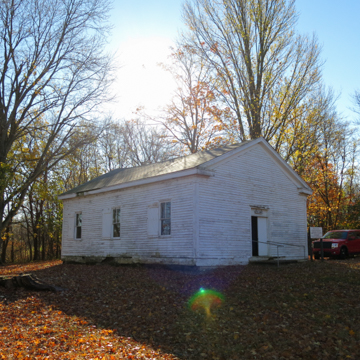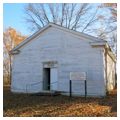You are here
Mount Pleasant Beech Church
The Mount Pleasant Beech Church is a significant site associated with the heritage of African Americans and multiracial people in Indiana during the nineteenth and twentieth centuries. This building is the last extant community landmark of the Beech Settlement, a rural African American farming community settled in the 1820s and occupied through the early twentieth century. The Beech Church has served as the site of an annual homecoming reunion for descendants of the Beech Settlement every August since 1914.
The Beech Settlement was one of at least 30 Black farm communities established in Indiana between 1820 and 1850. Located mostly in central and southern Indiana, these communities were often established in proximity to settlements of the Religious Society of Friends, commonly known as the Quakers. During the first half of the nineteenth century, many Quakers became active as abolitionists, helping the enslaved escape through the network now known as the Underground Railroad. Quakers left slave states like North Carolina en masse during the early nineteenth century, separating themselves from the slave-based economy of the South while seeking new lives on the western frontier. The Beech Settlement was established in the late 1820s, when members of the Roberts family, free African Americans from Northampton County, North Carolina, settled in Ripley Township of Rush County, Indiana, among Quakers who had come to the area earlier in the decade. The 1830 census documents 14 Black households containing 91 individuals in Rush County. By 1850, 27 Black landowners held 2,144 acres in Ripley Township. Black landownership peaked in 1870 with 34 owners holding 2,496 acres. This decreased gradually during the 1870s and more rapidly during the 1880s and 1890s. By 1900, 18 Black landowners held 866 acres of land in Ripley Township, meaning that more than 65 percent of Black-owned land from 1870 had been transferred to white ownership.
The Beech Church served an active congregation from the 1830s through the 1910s. It was the site of the establishment of the Indiana Conference of the African Methodist Episcopal (A.M.E.) Church in 1840. This marked a significant phase of the growth of the denomination as Americans moved westward during the nineteenth century. As the first A.M.E. Church in Indiana, the Beech Church served as a parent and precedent for numerous other congregations that would be formed throughout the state over the following decades. In addition to its religious significance, the A.M.E. Church was a key organization in the promotion of education for African Americans, creating educational opportunities when state law and white hostility prohibited the children of Black taxpayers from attending Indiana’s public schools. The Beech Settlement’s location among Quaker communities suggests that it may have been connected with the Underground Railroad.
The Mount Pleasant Beech Church is a one-story, gable-front, wood-frame building with weatherboard siding and vernacular details reflecting the influence of the Greek Revival style. The building measures 40 feet in length from east to west and just over 30 feet in width from north to south. The building’s wooden structure originally rested on a series of granite boulders. A simple wooden frieze and cornice runs along the north and south elevations, with cornice returns at the east and west gable ends. Narrow pilasters trim the building’s four corners. All exterior trim is composed of flat wooden components, with no routed moldings. The west facade features a central entrance, possibly replacing two separate gender-segregated entrances typical of Protestant churches in Indiana during the mid-nineteenth century. The north and south elevations are identical; they are divided into three bays, each containing a window opening. The east elevation is divided into three bays with window openings centered in the outer two bays. The windows’ simple frames include a square profile and a flat wooden cap molding to divert rainwater from the head of the window. The double-hung sash appear to have originally been made as two-over-two windows, although several have been modified into a one-over-one configuration.
The interior of the Beech Church is one large, rectangular room. Two large trusses within the attic span between the north and south walls allow an open first-floor space without columns. Modern wood posts have been added below the center of each truss. A semicircular raised platform or dais is centered on the east wall. It is surrounded by a low railing with turned balusters, and the newel posts carry ball finials. The church retains wooden pews believed to be original.
The Beech Church’s annual homecoming reunion has helped the descendants of the Beech Settlement maintain the identity of their ancestral community generations after most families left the Carthage area. As one of the last surviving sites associated with a rural African American community in Indiana, the Beech Church offers a unique connection to a critical aspect of the state’s history and a dimension of the Hoosier experience distinct from that of Euro-Americans during the same period. The building provides a tangible connection to the experiences of African American Hoosiers, whose stories have often been overlooked or suppressed by the Euro-American majority. The Beech Church is a testament to the work and perseverance of free Black settlers who came to Indiana during the 1820s and 1830s, documenting the existence and achievements of the Beech Settlement community through several generations within the larger context of Indiana history.
References
1834–1934 Carthage Centennial. Carthage, IN: n.p., 1934.
“African Conference.” Knightstown Courier, August 28, 1841. Reprinted in Indiana American (Brookville, Indiana), September 3, 1841.
“Annual Home Coming and Basket Meeting.” Flyer in the collection of Douglas A. Jones, 1925.
Carter, Lawrence B. “Many Happy Times for Years.” Unidentified news clipping, August 24, 1951.
“Church History Told at Family Reunion.” Rushville Republican (Rushville, Indiana), September 2, 1976.
Constitution of the State of Indiana. New Albany, IN: Kent and Norman, 1851.
Cravey, Georgia. “Early Black Settlements: Rush County.” Indiana Historical Society. Accessed March 14, 2018. http://www.indianahistory.org/.
Fuller, Paul. Black Methodists in America: A Success Story of a Model Minority. Baltimore: Publish America, 2012.
Gary, A. L., and E. B. Thomas. Centennial History of Rush County, Indiana. Vol. I. Indianapolis: Historical Publishing Company, 1921.
Graham, Audrey Acton, “Allen Chapel African Methodist Episcopal Church,” Vigo County, Indiana. National Register of Historic Places Inventory–Nomination Form, 1975. National Park Service, U.S. Department of the Interior, Washington, D.C.
History of Rush County, Indiana. Chicago: Brant and Fuller, 1888.
“Homecoming Mt. Pleasant Beech Church.” Rushville Republican (Rushville, Indiana), August 22, 1973.
In Memoriam: Funeral Services in Respect to the Memory of Rev. William Paul Quinn. Toledo: Warren Chapel, 1873.
Indiana Historic Sites and Structures Inventory. Rush County Interim Report. Indianapolis: Historic Landmarks Foundation of Indiana, 1988.
Indiana Historical Bureau. “Being Black in Indiana.” Accessed February 11, 2016, http://www.in.gov/.
Indiana Historical Society. Mount Pleasant Library, (Rush County, Ind.), Records, 1842-1869, Minutes Book. Indiana Historical Society Library, Indianapolis, Indiana.
Loewen, James W. Sundown Towns: A Hidden Dimension of American Racism. New York: New Press, 2005.
Moore, Wilma L. “Collection # F0562, Lawrence B. Carter Notebooks, N.D.” Manuscript and Visual Collections Department, William Henry Smith Memorial Library, Indiana Historical Society, Indianapolis, Indiana.
O’Bryan, Ann. “Mt. Pleasant Library: Reading among African Americans in 19th Century Rush County, Indiana.” Indiana University. Accessed December 2, 2015. http://hdl.handle.net/1805/403.
Reed, Thomas J. Bethel, “A.M.E. Church,” Wayne County, Indiana. National Register of Historic Places Inventory–Nomination Form, 1974. National Park Service, U.S. Department of the Interior, Washington, D.C.
Smith, Charles Spencer. A History of the African Methodist Episcopal Church. Philadelphia: Book Concern of the A.M.E. Church, 1922.
Thornbrough, Emma Lou. The Negro in Indiana: A Study of a Minority. Indianapolis: Indiana Historical Bureau, 1957.
Vincent, Stephen A. Southern Seed, Northern Soil: African-American Farm Communities in the Midwest, 1765-1900. Bloomington: Indiana University Press, 1999.
Wright, Richard R., Jr., ed. Centennial Encyclopedia of the African Methodist Episcopal Church. Philadelphia: Book Concern of the A.M.E. Church, 1916.
Writing Credits
If SAH Archipedia has been useful to you, please consider supporting it.
SAH Archipedia tells the story of the United States through its buildings, landscapes, and cities. This freely available resource empowers the public with authoritative knowledge that deepens their understanding and appreciation of the built environment. But the Society of Architectural Historians, which created SAH Archipedia with University of Virginia Press, needs your support to maintain the high-caliber research, writing, photography, cartography, editing, design, and programming that make SAH Archipedia a trusted online resource available to all who value the history of place, heritage tourism, and learning.




